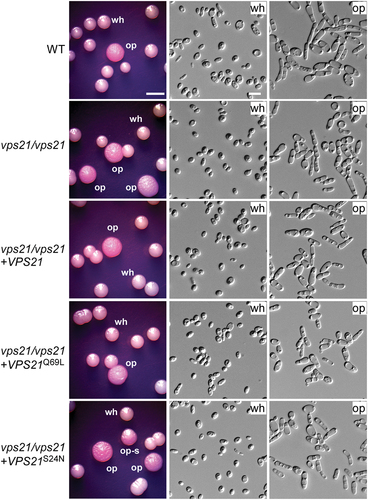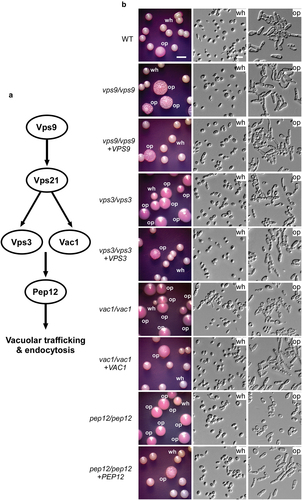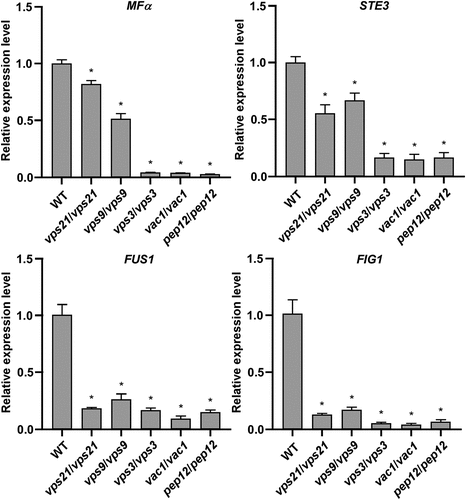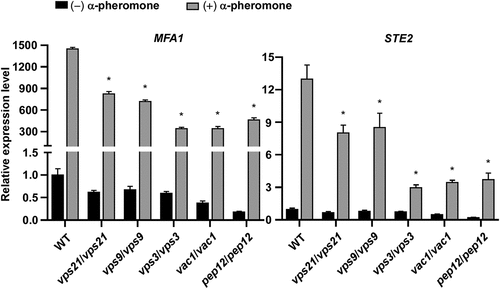Figures & data
Figure 1. Function of Vps21 and its variants in the regulation of white-to-opaque switching. White cells of the WT control, vps21/vps21 mutant, and reconstituted strains were initially grown on Lee’s glucose medium (pH 6.8) at 25 °C for 7 days. Candida albicans cells of homogeneous white colonies were replated onto Lee’s GlcNAc medium (pH 6.8) and incubated at 25 °C for 5 days. wh, white; op, opaque; op-s, opaque-sectored (colonies containing both white and opaque cells). Scale bar for cells, 10 μm; Scale bar for colonies, 2 mm. Strains used: WT (FDZF208); vps21/vps21 (FDZF263); vps21/vps21 + VPS21 (FDZF489); vps21/vps21 + VPS21S24N (FDZF475); and vps21/vps21 + VPS21Q69L (FDZF473). The mating type of all strains used was MTLa/Δ. The switching frequencies are presented in .

Table 1. White-opaque switching frequencies of the WT control and mutant strains of the Vps21 signalling pathway.
Figure 2. Deletion of VPS9, VPS3, VAC1, and PEP12 promotes white-to-opaque switching. (a) Schematic diagram of the Vps21 signaling pathway. Vps9, a guanine nucleotide exchange factor (GEF) of Vps21; Vps3, a CORVET tethering complex component; Vac1, a vesicle transport protein; and Pep12, a t-SNARE involved in prevacuolar trafficking. (b) White-to-opaque switching assays. White cells of the WT control, vps9/vps9, vps3/vps3, vac1/vac1, and pep12/pep12 mutant, and corresponding reconstituted strains were initially grown on Lee’s glucose medium (pH 6.8) for 7 days. Candida albicans cells of homogeneous white colonies were replated onto Lee’s GlcNAc medium (pH 6.8) and incubated at 25 °C for 5 days. Wh, white; op, opaque. Scale bar for cells, 10 μm; Scale bar for colonies, 2 mm. Strains used: WT (FDZF208); vps9/vps9 (FDZF213); vps3/vps3 (FDZF259); vac1/vac1 (FDZF531); pep12/pep12 (FDZF546); vps9/vps9 + VPS9 (FDZF491); vps3/vps3 + VPS3 (FDZF493); vac1/vac1 + VAC1 (FDZF548); and pep12/pep12 + PEP12 (FDZF549). The mating type of all strains used was MTLa/Δ. The switching frequencies are presented in .

Table 2. Mating efficiencies of the WT control and mutant strains of the Vps21 signalling pathway.
Figure 3. Relative transcriptional expression of mating associated genes in the WT control and mutant strains of the Vps21 signalling pathway. Opaque cells of the WT control, vps21/vps21, vps9/vps9, vps3/vps3, vac1/vac1, and pep12/pep12 mutant strains were incubated in liquid Lee’s glucose medium (pH 6.8) for 24 hours at 25 °C. Total RNA was extracted for quantitative RT-PCR assays. The expression level of ACT1 was used for normalisation. The average value of the WT control strain for each gene was set as “1”. “*” indicates significant difference between the WT control strain and mutant strain (p < 0.05, two-tailed Student’s t-test). Strains used: WT (FDZF171); vps21/vps21 (FDZF266); vps9/vps9 (FDZF212); vps3/vps3 (FDZF250); vac1/vac1 (FDZF533); and pep12/pep12 (FDZF534). The mating type of all strains used was MTLΔ/α.

Figure 4. Relative transcriptional expression of MFA1 and STE2 in the absence and presence of α-pheromone in the WT control and mutant strains of the Vps21 signalling pathway. Opaque cells of the WT control, vps21/vps21, vps9/vps9, vps3/vps3, vac1/vac1, and pep12/pep12 mutant strains were incubated in liquid Lee’s glucose medium (pH 6.8) and treated with or without synthetic α-pheromone (50 μg/mL) for 12 hours at 25 °C. Total RNA was extracted for quantitative RT-PCR assays. The expression level of ACT1 was used for normalisation. The average value of the WT control strain for each gene without pheromone treatment was set as “1”. “*” indicates significant difference between the WT control strain and mutant strain (p < 0.05, two-tailed Student’s t-test). Strains used: WT (FDZF208); vps21/vps21 (FDZF263); vps9/vps9 (FDZF213); vps3/vps3 (FDZF259); vac1/vac1 (FDZF531); and pep12/pep12 (FDZF546). The mating type of all strains used was MTLa/Δ.

